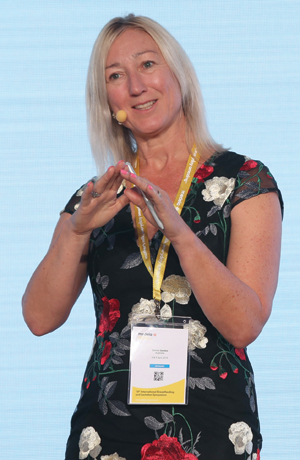Leading lactation researchers call for more own mother’s milk, for more babies, for longer
Nine of the world’s leading researchers in the field of lactation presented their most recent discoveries at Medela’s 14th International Breastfeeding and Lactation Symposium in London in April 2019. This globally respected event united more than 400 like-minded professionals, from 40 countries, who believe in the value of human milk.
Katie JamesGlobal Education Manager
Nania G. Schärer-Hernández
Director Global Education
Medela AG, Switzerland
The audience of health professionals and researchers shared new knowledge, including findings of how breast milk components work with one another to defend against infection and allergies, the development of the infant microbiome, the unique value human milk has for the most vulnerable infants in the neonatal intensive care unit (NICU), as well as translating research into best practice to ensure better overall milk volumes for the infant and mother.
The value of human milk
Dr Subhash Pokhrel, Brunel University London, presented on the business of breastfeeding. Health economists have found that a new mother is much more likely to choose to breastfeed if she feels there are more incentives than disincentives. Dr Pokhrel explored how suboptimal breastfeeding continues to result in an economic burden to our society and asks for governments and other healthcare providers to utilise a return on investment (ROI) method to make clear business cases to identify the most successful support programmes that target improved breastfeeding rates and provide the greatest ROI to the community.

Dr Subhash Pokhrel.
The unique components of breast milk
Associate Professor Donna Geddes, Director of the Human Lactation Research Group at the University of Western Australia, has found that appetite-controlling hormones, such as leptin and adiponectin, are present in breast milk. While these hormones currently exist in some infant formula, they are not only in lower doses but they cannot adapt in the way that those in breast milk can to the individual infant’s stage of development. Human milk has the unique ability to tailor every feed to the infant’s specific needs, providing a precise dose of each required hormone. These hormones do more than determine growth rates, they actually signal how much fat compared to lean tissue the infant’s body should develop, leading to the current belief that this has implications for reducing the risk of both childhood and later obesity.

Associate Professor Donna Geddes.
“The volume of milk intake is governed by the baby’s appetite and the concentration of appetite hormone is determined by the mother. This suggests a truly unique two-way relationship between the mother and the baby to determine the exact hormone dose an infant requires,” said Dr Geddes.
Lessons from the wallaby
Professor Kevin Nicholas, Monash Institute of Pharmaceutical Sciences, Australia, presented his fascinating work on the tammar wallaby, a marsupial with a gestation period of only 26 days, whose young are born very immature and fully develop in the pouch for eight to nine months while nourished with milk. Prof Nicholas’ work is now looking into the theory that biological markers equivalent to those found in tammar wallaby milk could also be present in the human placenta, amniotic fluid and colostrum. Understanding this science could lead to the isolation of factors relevant to development of the human preterm infant.
The powerful effects of starting the gut off right
Dr Maria Carmen Collado, Institute of Agrochemistry and Food Technology, Spain, reinforced the latest understanding that the early microbial colonisation of the infant gut is critical for both short and long-term health. Importantly, the microbiota of own mother’s milk drives that early colonisation. There is even a link between the milk microbiome and the broader macronutrient composition, in particular the oligosaccharides. In brand new research, Dr Collado also confirmed the presence of yeast and fungi in the milk of healthy mothers. This initial early ‘seeding’ of an infant’s gut with the right bacteria and even fungal species from the own mother’s milk not only aids in the prevention of infection and certain illnesses in the infant but has also been linked with ongoing long-term health into adulthood.
“Each mother’s unique microbiota shapes the milk she passes on to her infant, and each feed is a personalised microbial inheritance,” said Dr Collado.
Mother and baby’s synergistic effects on breast milk
Dr Daniel Munblit, Associate Professor at Sechenov University, Russia, issued a call to action for allergy researchers to shift their focus from individual immune markers or groups and instead consider the symbiotic effects of multiple immune markers.
Breastfeeding is a natural vaccine. In particular colostrum, which has high concentrations of cytokines, is crucial in the development of the infant’s immune system. This emphasises the importance of early (<1hr) feeding for all newborns. Importantly, Dr Munblit highlighted the overall complexity of the immune factors in human milk and how they differ in milk from mums in different parts of the world but are tailored to the immune needs of the infant.
Dr Munblit explained: “Breast milk is full of different components that have synergistic and/or antagonistic effects to each other. It is these intricate interactions, which we are getting closer to uncovering, that play a part in breast milk’s ability to protect an infant against allergies.”
The use of human milk in the NICU
Dr Daniel Klotz, University of Freiburg, Germany, spoke of the alarming differences in practice in how NICUs handle human milk. Looking at more than 100 hospitals it was clear that there was a staggering variation in clinical management.
Human milk is a living fluid that contains many diverse components, such as over 1,000 different proteins, hundreds of different fats and living cells – white blood cells and stem cells. All of these have specific roles in keeping the infant healthy and prevent future infection and disease.
Incorrect milk handling practices, particularly for the vulnerable infant in the NICU, can reduce or destroy many proteins, vitamins, live cells, antibodies, etc and change the complexity of the milk itself. Dr Klotz explained that without standardised guidelines clinicians are at risk of missing out on the full life-saving potential of using human milk with vulnerable infants. Dr Klotz outlined the need for new evidence-based national guidelines that regulate the handling of both mother’s own and donor milk.
Milk feeds: from zero to hero
Dr Janet Berrington, Consultant in Neonatal Paediatrics and Honorary Senior Clinical Lecturer at Newcastle University, highlighted that how hospitals choose to feed their vulnerable preterm infants ultimately impacts on their early health outcomes.
Infection rates, necrotising enterocolitis and the ability of the infant to tolerate feeds and grow effectively, as well as the development of later problems such as obesity, asthma, allergy and metabolic health, are all affected by how soon (or delayed) milk is introduced to the infant’s gut.

Dr Janet Berrington.
Dr Berrington gave delegates a sneak preview of the cutting-edge technology her research team has devised to investigate infant gut health and the impact of when first milk is introduced. By collecting the infant’s ‘by-products’ (stool, urine and residual breast milk samples) they have created a biobank repository of information and study samples. Furthermore, a ‘mini-gut’ has been developed from stem cells offering unique insights into how the preterm infant’s gut intricately develops over time.
Dr Berrington said: “For the first time we now have a real model of very early gestation human gut tissue that can be used in our research, which will hopefully allow a better understanding of the drivers of gut health and disease in preterm infants.”
Breastfeed with confidence
Dr Jacqueline Kent, Hartmann Human Lactation Research Group, University of Western Australia, focused on the importance of normal breastfeeding patterns. Dr Kent explained that when mothers are aware that there is a range of ‘normal’ they are more likely to feel confident with their personal breastfeeding experience. Around half of the mothers who seek breastfeeding assistance are concerned about how often their infant breastfeeds and how long a breastfeed should last. They are not confident they have enough milk for their infant.

Dr Jacqueline Kent.
Gathering 24-hour milk volume profiles of the mothers in her study, Dr Kent gathered significant data on the real ranges of what is normal for a healthy exclusively breastfeeding infant. From the milk profiles of 212 healthy, term breastfeeding dyads with infants aged 1-6 months, the range of normal breastfeeds per day was 6-17, with infants spending anywhere from 6-24 minutes per breastfeed, drinking 32-131mL each time, which added up to intakes of between 528-1116mL of breast milk per day. The data clearly demonstrate very wide ranges among normal mothers and infants. Most mothers can take reassurance that they are feeding their infant normally despite no two infants breastfeeding alike.
Changing the practice paradigm
Professor Diane Spatz, Penn University of Pennsylvania School of Nursing and Children’s Hospital of Philadelphia, USA, called for healthcare providers to change what they teach in antenatal education classes and their early postnatal breast-feeding support practices to help more mothers reach their personal breast milk feeding goals. Prof Spatz spoke about the need for clinicians to be aware that there is a sense of urgency when helping mothers in the first few hours and days to intitate and ‘switch on’ effective milk production. Common early hospital practices can either positively or negatively impact a mother’s ability to be able to make enough milk for her infant over the long term. Considering almost half of all mothers report concerns with their milk supply, Prof Spatz explained to the audience how simple, but proven, effective measures can result in amazing increases in the number of mothers able to provide a full breast milk diet for their infant.

Professor Diane Spatz.
Continuing the global breastfeeding story
Dr Leon Mitoulas, Head of Medical Research at Medela AG, added: “We know that consistent breastfeeding research supports women and infant health, which is why we are committed to bringing together some of the brightest minds in lactation science. Each new advance helps us learn more about the important components of human milk and how to support mums in reaching breast milk feeding goals.
“Even though breast milk is universally accepted as being the best for baby, we continue to make groundbreaking discoveries and it is evident from what we heard during the symposium that there is still so much for us to learn in order to truly understand its capabilities.”
Or read this article in our
Tablet/iPad edition


